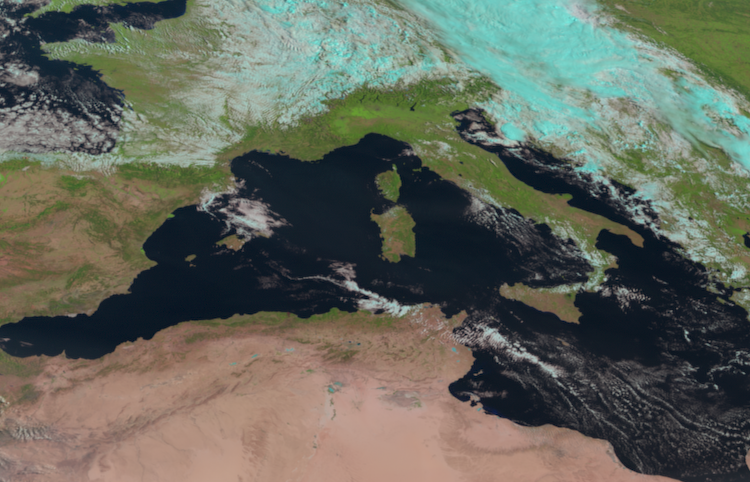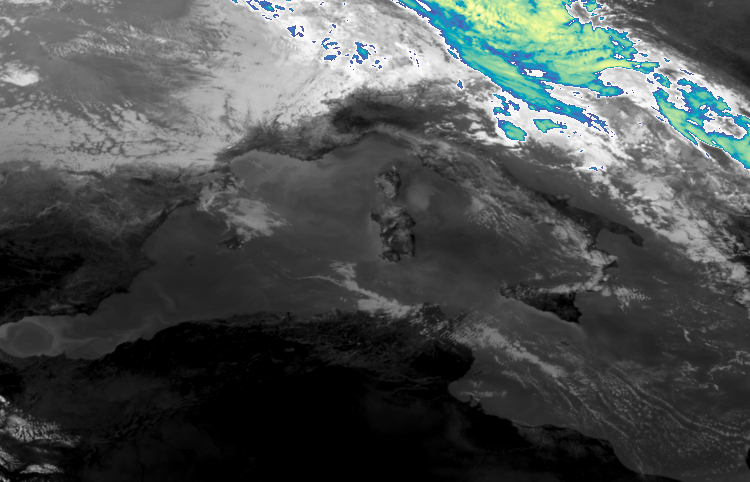High rate SEVIRI Level 1.5 Image Data MSG - Data Access
This notebook demonstrates how to access SEVIRI data using HDA and how to read, process and visualize it.
The Spinning Enhanced Visible and InfraRed Imager (SEVIRI) is MSG’s primary instrument and has the capacity to observe the Earth in 12 spectral channels.
Documentation DestinE Data Lake HDA s High Rate SEVIRI Level 1.5 Image Data - MSG - 0 degree
Authenticate on DESP¶
import destinelab as deauthimport requests
import json
import os
import zipfile
import datetime
import shutil
from getpass import getpassDESP_USERNAME = input("Please input your DESP username or email: ")
DESP_PASSWORD = getpass("Please input your DESP password: ")
auth = deauth.AuthHandler(DESP_USERNAME, DESP_PASSWORD)
access_token = auth.get_token()
if access_token is not None:
print("DEDL/DESP Access Token Obtained Successfully")
else:
print("Failed to Obtain DEDL/DESP Access Token")
auth_headers = {"Authorization": f"Bearer {access_token}"}Please input your DESP username or email: eum-dedl-user
Please input your DESP password: ········
Response code: 200
DEDL/DESP Access Token Obtained Successfully
Search MSG data¶
response = requests.post("https://hda.data.destination-earth.eu/stac/search", headers=auth_headers, json={
"collections": ["EO.EUM.DAT.MSG.HRSEVIRI"],
"datetime": "2023-08-06T08:00:00Z/2023-08-07T00:00:00Z"
})
from IPython.display import JSON
product = response.json()["features"][0]
JSON(product)Download MSG¶
from tqdm import tqdm
import time
# Define a list of assets to download
#assets = ["Oa08_radiance.nc", "Oa06_radiance.nc", "Oa02_radiance.nc"]
assets = ["downloadLink"]
for asset in assets:
download_url = product["assets"][asset]["href"]
print(download_url)
filename = asset
print(filename)
response = requests.get(download_url, headers=auth_headers)
total_size = int(response.headers.get("content-length", 0))
print(f"downloading {filename}")
with tqdm(total=total_size, unit="B", unit_scale=True) as progress_bar:
with open(filename, 'wb') as f:
for data in response.iter_content(1024):
progress_bar.update(len(data))
f.write(data)https://hda.data.destination-earth.eu/stac/collections/EO.EUM.DAT.MSG.HRSEVIRI/items/MSG3-SEVI-MSG15-0100-NA-20230806081241.839000000Z-NA/download?provider=eumetsat
downloadLink
downloading downloadLink
100%|██████████| 174M/174M [00:00<00:00, 600MB/s]
zf=zipfile.ZipFile(filename)
with zipfile.ZipFile(filename, 'r') as zip_ref:
zip_ref.extractall('.')satpy¶
The Python package satpy supports reading and loading data from many input files. For MSG data and the Native format, we can use the satpy reader 'seviri_l1b_native.
pip install --quiet satpyNote: you may need to restart the kernel to use updated packages.
Import required libraries
from satpy.scene import Scene
from satpy.composites import GenericCompositor
from satpy.writers import to_image
from satpy.resample import get_area_def
from satpy import available_readers
import warnings
warnings.filterwarnings('ignore')
warnings.simplefilter(action = "ignore", category = RuntimeWarning)file='MSG3-SEVI-MSG15-0100-NA-20230806081241.839000000Z-NA.nat'Read and load data¶
We use the Scene constructor from the satpy library, a Scene object represents a single geographic region of data. Once loaded we can list all the available bands (spectral channel) for that scene.
# read the file
scn = Scene(reader='seviri_l1b_native', filenames=[file])
# print available datasets
scn.available_dataset_names()['HRV',
'IR_016',
'IR_039',
'IR_087',
'IR_097',
'IR_108',
'IR_120',
'IR_134',
'VIS006',
'VIS008',
'WV_062',
'WV_073']With the function load(), you can specify an individual band by name. If you then select the loaded band, you see the xarray.DataArray band object
# load bands
scn.load(['HRV','IR_108'])
scn['IR_108']scn['IR_108'].attrs.keys()dict_keys(['orbital_parameters', 'units', 'wavelength', 'standard_name', 'platform_name', 'sensor', 'georef_offset_corrected', 'time_parameters', 'start_time', 'end_time', 'reader', 'area', 'name', 'resolution', 'calibration', 'modifiers', '_satpy_id', 'ancillary_variables'])scn['IR_108'].attrs['wavelength']WavelengthRange(min=9.8, central=10.8, max=11.8, unit='µm')Visualize data combining bands¶
The Satpy function available_composite_ids() returns a list of available composite IDs.
scn = Scene(reader="seviri_l1b_native",
filenames=[file])scn.available_composite_ids()[DataID(name='24h_microphysics'),
DataID(name='airmass'),
DataID(name='ash'),
DataID(name='cloud_phase_distinction'),
DataID(name='cloud_phase_distinction_raw'),
DataID(name='cloudtop'),
DataID(name='cloudtop_daytime'),
DataID(name='colorized_ir_clouds'),
DataID(name='convection'),
DataID(name='day_microphysics'),
DataID(name='day_microphysics_winter'),
DataID(name='dust'),
DataID(name='fog'),
DataID(name='green_snow'),
DataID(name='hrv_clouds'),
DataID(name='hrv_fog'),
DataID(name='hrv_severe_storms'),
DataID(name='hrv_severe_storms_masked'),
DataID(name='ir108_3d'),
DataID(name='ir_cloud_day'),
DataID(name='ir_overview'),
DataID(name='ir_sandwich'),
DataID(name='natural_color'),
DataID(name='natural_color_nocorr'),
DataID(name='natural_color_raw'),
DataID(name='natural_color_raw_with_night_ir'),
DataID(name='natural_color_with_night_ir'),
DataID(name='natural_color_with_night_ir_hires'),
DataID(name='natural_enh'),
DataID(name='natural_enh_with_night_ir'),
DataID(name='natural_enh_with_night_ir_hires'),
DataID(name='natural_with_night_fog'),
DataID(name='night_fog'),
DataID(name='night_ir_alpha'),
DataID(name='night_ir_with_background'),
DataID(name='night_ir_with_background_hires'),
DataID(name='night_microphysics'),
DataID(name='overview'),
DataID(name='overview_raw'),
DataID(name='realistic_colors'),
DataID(name='rocket_plume_day'),
DataID(name='rocket_plume_night'),
DataID(name='snow'),
DataID(name='vis_sharpened_ir')]composite_id = ["natural_color"]
scn.load(composite_id, upper_right_corner="NE")
scn_cropped = scn.crop(ll_bbox=(-5, 31, 20, 51))
scn_cropped.show("natural_color")
composite_id = ["colorized_ir_clouds"]
scn.load(composite_id, upper_right_corner="NE")scn_cropped = scn.crop(ll_bbox=(-5, 31, 20, 51))
scn_cropped.show("colorized_ir_clouds")